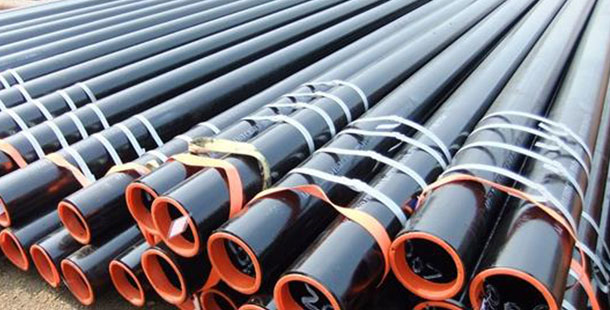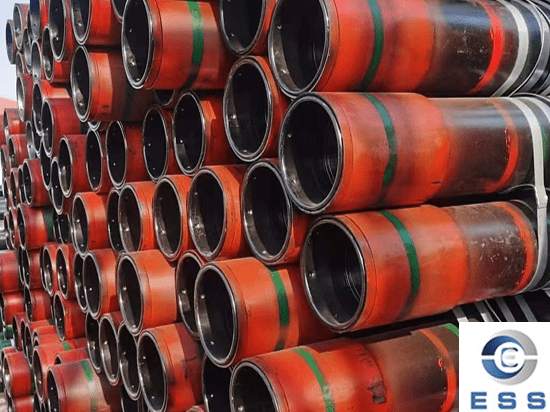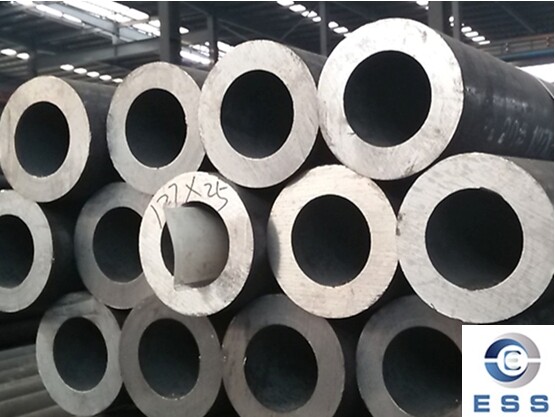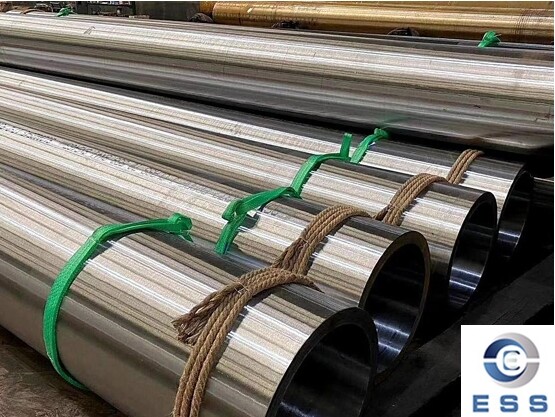Seamless steel pipe is a round, square and rectangular steel with a hollow section and no joints on the periphery. Seamless steel pipes are made of steel ingots or solid tube billets through perforation into capillary tubes, and then made by hot rolling, cold rolling or cold drawing.
welded pipe is a kind of steel pipe. As an important part of steel products, steel pipe is divided into welded steel pipe (plate, billet) and seamless steel pipe (round billet) because of its manufacturing process and different shape of the billet. Engineering construction departments rarely use seamless steel pipe, with mostly steel plate steel belt welded steel pipe, referred to as welded pipe. Scaffold steel pipe is a kind of straight weld welded pipe.

(1) Welding steel pipe
The billet used for welded steel pipe is steel plate or strip steel, which is divided into furnace welding pipe, electric welding (resistance welding) pipe and automatic arc welding pipe due to different welding processes. Because of the different forms of welding into straight seam welded pipe and spiral welded pipe two. Because of its end shape is divided into circular welded pipe and special (square, flat, etc.) welded pipe. Welded pipes are divided into the following varieties because of their different materials and uses:
✤ GB/T3091-1993 (galvanized welded steel pipe for low pressure fluid delivery). Mainly used for conveying water, gas, air, oil and heating hot water or steam and other general lower pressure fluid and other purposes of pipe. Its representative material Q235A steel.
✤GB/T3092-1993 (galvanized welded steel pipe for low pressure fluid delivery). It is mainly used for conveying water, gas, air, oil and heating water or steam and other low pressure fluids and other purposes. Its representative material is: Q235A steel.
✤GB/T14291-1992 (Welded steel pipes for fluid transport in mines). It is mainly used for straight seam welding steel pipe for mine air pressure, drainage and shaft gas discharge. Its representative material Q235A, B - grade steel.
✤GB /T14980-1994 (large diameter welded steel pipe for low pressure fluid delivery) Mainly used for conveying water, sewage, gas, air, heating steam and other low pressure fluid and other uses. Its representative material Q235A steel.
✤GB/T12770-1991 (Stainless steel welded steel pipes for mechanical structures). Mainly used in machinery, automobile, bicycle, furniture, hotel and restaurant decoration and other mechanical parts and structural parts. Its representative material 0Cr13, 1Cr17, 00Cr19Ni11, 1Cr18Ni9, 0Cr18Ni11Nb, etc.
✤GB/T12771-1991 (Welded stainless steel pipes for fluid transport). Mainly used for conveying low pressure corrosive media. The representative materials are 0Cr13, 0Cr19Ni9, 00Cr19Ni11, 00Cr17, 0Cr18Ni11Nb, 0017Cr17Ni14Mo2, etc.
(2) seamless steel pipe
Because of its different manufacturing technology, it is divided into hot rolled (extruded) seamless steel pipe and cold drawn (rolled) seamless steel pipe. Cold drawn (rolled) pipe is divided into two types: round pipe and special-shaped pipe.
a. Hot rolling (extruded seamless steel pipe) : round tube billet → heating → perforation → three-roll diagonal rolling, continuous rolling or extrusion → pipe stripping → sizing (or reducing) → cooling → billet → straightening → hydrostatic test (or flaw detection) → marking → storage.
Cold drawing (rolled) seamless steel tube: round tube blank → heating → perforation → heading → annealing → pickling → oiling (copper plating) → multi-pass cold drawing (cold rolling) → blank tube → heat treatment → straightening → hydrostatic test (flaw detection) → marking → storage.
b. Seamless steel tubes are divided into the following varieties because of their different uses:
✤GB/T8162-1999 (seamless steel tubes for structure). Mainly used in general structure and mechanical structure. Its representative material (brand number) : carbon steel 20, 45 steel; Alloy steel Q345, 20Cr, 40Cr, 20CrMo, 30-35CrMo, 42CrMo, etc.
✤GB/T8163-1999 (seamless steel pipe for conveying fluid). It is mainly used for conveying fluid pipelines on engineering and large equipment. The representative material (grade) is 20, Q345, etc.
✤Gb3087-1999 (seamless steel tube for low and medium pressure boiler). It is mainly used for conveying low and medium pressure flow in industrial boilers and domestic boilers. The representative material is 10, 20 steel.
✤Gb5310-1995 (seamless steel tubes for high pressure boilers). It is mainly used for high temperature and high pressure conveying fluid collection box and pipeline in power plant and nuclear power plant boiler. The representative material is 20G, 12Cr1MoVG, 15CrMoG, etc.
✤Gb5312-1999 (seamless steel tubes of carbon steel and carbon manganese steel for Marine use). Mainly used for ship boiler and superheater I, II class pressure tube. Representative material for 360, 410, 460 steel class.
✤Gb1479-2000 (seamless steel pipe for high pressure fertilizer equipment). It is mainly used for conveying high temperature and high pressure fluid pipe on chemical fertilizer equipment. The representative material is 20, 16Mn, 12CrMo, 12Cr2Mo, etc.
✤Gb9948-1988 (seamless steel pipe for petroleum cracking). It is mainly used in boilers, heat exchangers and fluid pipelines of petroleum smelters. Its representative material is 20, 12CrMo, 1Cr5Mo, 1Cr19Ni11Nb and so on.
✤Gb18248-2000 (seamless steel pipe for gas cylinders). Mainly used for making various gas and hydraulic cylinders. Its representative material is 37Mn, 34Mn2V, 35CrMo, etc.
✤GB/T17396-1998 (Hot rolled seamless steel tubes for hydraulic supports). Mainly used for making coal mine hydraulic support and cylinder, column, and other hydraulic cylinder, column. Its representative material is 20, 45, 27SiMn and so on.
✤Gb3093-1986 (high pressure seamless steel pipe for diesel engine). Mainly used for diesel injection system high pressure tubing. Its steel pipe is generally cold drawn, and its representative material is 20A. GB/T3639-1983 (cold drawn or cold rolled precision seamless steel pipe) Mainly used for mechanical structure, carbon pressing equipment, to obtain high dimensional accuracy, good surface finish steel pipe. Its representative material 20, 45 steel, etc.
✤GB/T3094-1986 (cold-drawn seamless steel tube, special-shaped steel tube). It is mainly used to make various structural parts and parts, and its material is high quality carbon structural steel and low alloy structural steel.
✤GB/T8713-1988 (Precision inner diameter seamless steel tubes for hydraulic and pneumatic tubes) Cold drawn or cold rolled seamless steel tubes with precise inner diameter for hydraulic and pneumatic cylinders. Its representative material is 20, 45 steel, etc.
✤Gb13296-1991 (stainless steel seamless steel tubes for boilers and heat exchangers). It is mainly used in boilers, superheaters, heat exchangers, condensers and catalytic tubes of chemical enterprises. High temperature, high pressure and corrosion resistant steel pipe. Its representative material is 0Cr18Ni9, 1Cr18Ni9Ti, 0Cr18Ni12Mo2Ti and so on.
✤GB/T14975-1994 (stainless steel seamless steel pipe for structure). Mainly USED FOR general structure (hotel, restaurant decoration) and chemical enterprise mechanical structure with air resistance, acid corrosion and a certain strength of steel pipe. Its representative material for 0-3CR13, 0Cr18Ni9, 1Cr18Ni9Ti, 0Cr18Ni12Mo2Ti.
✤GB/T14976-1994 (seamless stainless steel pipe for fluid transport). Mainly used for conveying corrosive media pipelines. Generation table material for 0Cr13, 0Cr18Ni9, 1Cr18Ni9Ti, 0Cr17Ni12Mo2, 0Cr18Ni12Mo2Ti. YB/T5035-1993 (seamless steel pipe for automobile half bushing). It is mainly used for the production of high quality carbon structural steel and alloy structural steel hot rolled seamless steel tubes for automobile half bushing and drive axle housing shaft pipe. Its representative materials are 45, 45Mn2, 40Cr, 20CrNi3A and so on.
✤API SPEC5CT-1999 (Casing and Tubing Specification), is produced and published by the American Petroleum Institute ("API") for use worldwide. Among them: casing: from the ground surface into the drilling hole, as the lining of the pipe, the pipe through the collar connection. The main materials are J55, N80, P110 and other steel classes, and hydrogen sulfide corrosion resistant C90, T95 and other steel classes. Its low steel grade (J55, N80) can be welded steel pipe.
✤Tubing: a pipe inserted from the ground surface into the casing until the oil layer, and the pipes are connected by a collar or integral connection. The role of the oil pumping unit will be the oil layer through the pipeline to the surface. The main material for J55, N80, P110, and hydrogen sulfide corrosion resistant C90, T95 steel grade. Its low steel grade (J55, N80) can be welded steel pipe.
✤API SPEC 5L-2000 (Pipeline Specification), prepared and published by the American Petroleum Institute, is used worldwide.
✤Pipeline pipe: is the shaft out of the ground oil, gas or water, through the pipeline delivery to the oil and gas industry enterprises. The pipeline pipe includes two kinds of seamless and welded pipe, the pipe end has a flat end, a threaded end and a socket end; The connection mode is end welding, collar connection, socket connection and so on. The main material of the pipe is B, X42, X56, X65, X70 and other steel grades.
seamless vs welded pipe
The difference in the basic manufacturing method is obvious from the names. Seamless tube is extruded and drawn from a billet while welded tube is produced from a strip that is roll formed and welded to produce a tube. Welded tube is considerably less expensive than seamless tube and is readily available in long continuous lengths.
Although the working pressure of welded tube is 20% less than that for a similar seamless tube, working pressure is not the determining factor for choosing seamless tube over welded tube for analyzer sample lines. The difference in potential impurities, which reduce the corrosion resistance of the finished tube, is why seamless tube is specified.
The weld area is considered to be inhomogeneous thus exhibiting different malleability and less corrosion resistance as well as greater dimensional variation. Drawing welded tube reduces these anomalies. Most tubing (seamless and welded) is drawn to produce final dimensional tolerances. Drawing is an operation, which “pulls” a tube through a die. There are different methods for drawing a tube however they can be thought of as sunk drawn and a plug drawn. The difference is seen in the ID surface roughness. A sunk drawn tube is done without internal support. Sink drawn tube reduces the diameter without controlling the wall thickness. There is some “crunching” of the ID and the tube develops a “sun burst” cross section and wrinkles circumferentially along the inside surface.
This can be especially noticeable around the weld on welded tubing. Plug or rod drawn tube is pulled through a die with internal support and produces a much smoother inner surface. Rod or plug drawing breaks up the weld bead on welded tubing and removes any dimensional indication. Final annealing further promotes a homogeneous tube. The term “full finished” refers to welded tubes that have been rod or plug drawn and annealed sufficiently to both remove any dimensional indication of the weld area and also break up the dendritic structure of the weld bead and expedite homogenization. Often it is very difficult to see the difference between welded and seamless tubing.
By code the allowable working pressure of welded tubing is reduced by 20%. The basis for much of today’s bias regarding seamless vs. welded tubing probably stems from early manufacturing processes when the weld area was not reworked to provide a homogeneous tube wall. Even today the standard for working the weld area is very open allowing great variance in the final product. Seamless tubing simply avoids the potential for any defect in the corrosion resistance of the weld area. While it is true that most welded tubing cannot be detected by the naked eye recognized standards for working the weld area of tubing are very open and allow great latitude in the degree of homogeneity in the final product.
So, what is the difference between seamless pipe and welded pipe?
1. Different materials
① Welded steel pipe: Welded steel pipe refers to steel pipes with seams on the surface after bending and deforming steel strips or steel plates into round or square shapes. The blanks used for welded steel pipes are steel plates or strip steels.
②Seamless steel pipe: a steel pipe made from a single piece of metal with no seams on the surface.
2. Different categories
① Welded steel pipe: According to different welding methods, it can be divided into arc welded pipe, high frequency or low frequency resistance welded pipe, gas welded pipe, furnace welded pipe, Bondi pipe, etc. According to the purpose, it is divided into general welded pipe, galvanized welded pipe, oxygen-blowing welded pipe, wire casing, metric welded pipe, roller pipe, deep well pump pipe, automobile pipe, transformer pipe, electric welded thin-walled pipe, electric welded special-shaped pipe and spiral welded pipe.
②Seamless steel pipes: seamless pipes are divided into hot-rolled pipes, cold-rolled pipes, cold-drawn pipes, extruded pipes, and top pipes. According to the cross-sectional shape, seamless steel pipes are divided into two types: round and special-shaped. Special-shaped pipes have square, elliptical, triangular, hexagonal, melon-shaped, star-shaped, and finned pipes. The maximum diameter is 650mm, and the minimum diameter is 0.3mm. According to different purposes, there are thick-walled pipes and thin-walled pipes.
3. Different uses
① Welded steel pipes: can be used as water gas pipes, etc., large diameter longitudinally welded pipes are used for high pressure oil and gas transportation, etc.; spiral welded pipes are used for oil and gas transportation, pipe piles, bridge piers, etc.
②Seamless steel pipes: used as petroleum geological drilling pipes, cracking pipes for petrochemical industry, boiler pipes, bearing pipes, and high-precision structural steel pipes for automobiles, tractors, and aviation.
Read more: Difference between seamless pipe and seam pipe













 Eastern Steel Manufacturing Co.,Ltd not only improve product production and sales services, but also provide additional value-added services. As long as you need, we can complete your specific needs together.
Eastern Steel Manufacturing Co.,Ltd not only improve product production and sales services, but also provide additional value-added services. As long as you need, we can complete your specific needs together.










